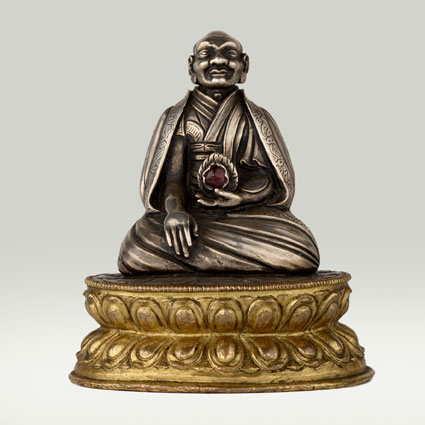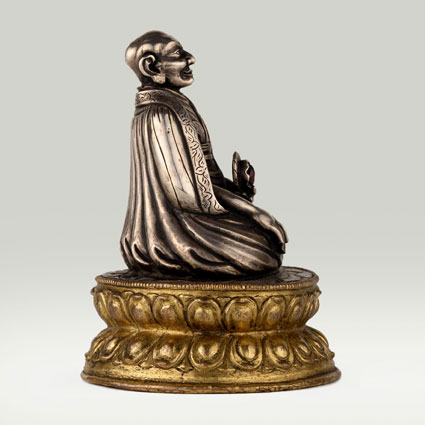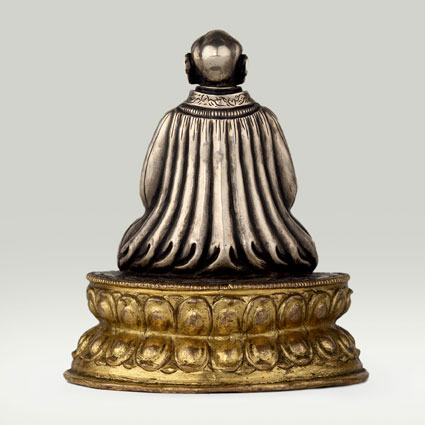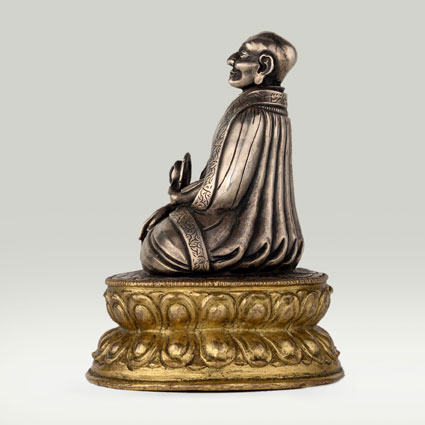Panchen Lama 04 Lobsang Chökyi Gyaltsen (1570-1662)
See it in the Museum
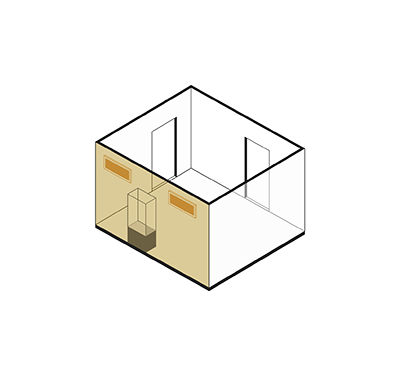
Reception desk
Orientation 3
Display 1

ABS 028
Code: ABS 028
Country: Tibet (central)
Style:
Date: 1650 - 1750
Dimensions in cm WxHxD: 7.4 x 8.8 x 6.4
Materials: Silver pedestal gilt copper
Panchen Rinpoche "Lobsang Chökyi Gyaltsen" (1569-1662)
Panchen Rinpoche "Lobsang Chökyi Gyaltsen" (1569-1662) was the fourth Panchen Lama of Tibet, yet he was the first to be awarded this title during his lifetime. Lobsang Chökyi Gyaltsen was the teacher and close ally of the Fifth Dalai Lama, Lozang Gyatso, called "the Great". He was a prolific writer, authoring more than three hundred works. The Fifth Dalai Lama gave Lobsang Chökyi Gyaltsen the monastery of Tashilhunpo and declared him to be an incarnation of Amitabha Buddha.
When Lobsang Chökyi Gyaltsen died in 1662 aged 93, the Fifth Dalai Lama immediately began the tradition of recognising the reincarnations of the Panchen Rinpoche. He composed a special prayer asking his master “to return” and ordered the monks of the great monasteries to recite it. He also reserved the title of Panchen (Great Scholar) exclusively for him, and this title has continued to be given to his successors and, posthumously, to his predecessors starting with Khedrup Je.
The master is clad in monastic robes and is seated in the diamond attitude (vajraparyankasana) on a single lotus throne. His right hand is resting on his shin. In his left hand he holds the "wishfulfilling jewel" (cintamani)on his lap, represented by a red garnet. The statue is not inscribed. The fact that the master is sitting on a lotus base indicates that this statue was commissioned after his death. In Tibet, only deceased monks are depicted on lotus pedestals, otherwise they are depicted sitting on cushions or even without pedestals.
The statue was chased from a silver alloy sheet and the throne is made of a hammered and gilded copper sheet. The upper edge of the throne is beaded. The base of the pedestal is sealed with a copper sheet adorned with the vishvavajra emblem.
Panchen Rinpoche "Lobsang Chökyi Gyaltsen" (1569-1662) was the fourth Panchen Lama of Tibet, yet he was the first to be awarded this title during his lifetime. Lobsang Chökyi Gyaltsen was the teacher and close ally of the Fifth Dalai Lama, Lozang Gyatso, called "the Great". He was a prolific writer, authoring more than three hundred works. The Fifth Dalai Lama gave Lobsang Chökyi Gyaltsen the monastery of Tashilhunpo and declared him to be an incarnation of Amitabha Buddha.
When Lobsang Chökyi Gyaltsen died in 1662 aged 93, the Fifth Dalai Lama immediately began the tradition of recognising the reincarnations of the Panchen Rinpoche. He composed a special prayer asking his master “to return” and ordered the monks of the great monasteries to recite it. He also reserved the title of Panchen (Great Scholar) exclusively for him, and this title has continued to be given to his successors and, posthumously, to his predecessors starting with Khedrup Je.
The master is clad in monastic robes and is seated in the diamond attitude (vajraparyankasana) on a single lotus throne. His right hand is resting on his shin. In his left hand he holds the "wishfulfilling jewel" (cintamani)on his lap, represented by a red garnet. The statue is not inscribed. The fact that the master is sitting on a lotus base indicates that this statue was commissioned after his death. In Tibet, only deceased monks are depicted on lotus pedestals, otherwise they are depicted sitting on cushions or even without pedestals.
The statue was chased from a silver alloy sheet and the throne is made of a hammered and gilded copper sheet. The upper edge of the throne is beaded. The base of the pedestal is sealed with a copper sheet adorned with the vishvavajra emblem.

